Written by: Zahrah Mazhar
Posted on: July 21, 2014 |  | 中文
| 中文
Blue Mosque
The city once ruled by the Ottoman and Byzantine empires is known for many things - such as its historical peninsula surrounded by the Golden Horn, Bosphorus and the Sea of Marmara, and for being the only confluence of Asia and Europe - but perhaps none as much as the magnificent mosques which make up one of the most recognised skylines of the world.
The mosques of Istanbul, which number in the thousands, came to be known for their architecture as much as for their historical significance over time, and if there is one man who can be singled out from the pages of history as the brains behind the design and structure of these holy places, it's Mimar Sinan.
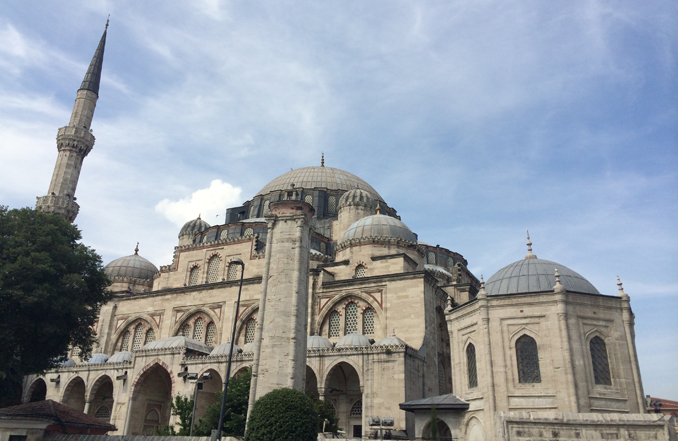 |
Sehzade Mosque |
As the chief Ottoman architect, he's been credited with the construction of more than 370 structures, which include at least 90 mosques or Camii in Turkish. Among them is the Sehzade Camii, a design from Sinan’s apprenticeship period. It was commissioned by Sultan Süleyman to commemorate the early death of his son, Sehzade Mehmed, in 1543. The sultan, also known as Süleyman the Magnificent, is said to have mourned the death of his son for 40 days at the site where the mosque complex stands today. The majority of imperial mosques in Istanbul were designed as a külliye - a complex of buildings which included a public kitchen, Quran schools, a hospital, hamams and more, and the Sehzade Camii was no different. Built atop the third hill of Istanbul, the mosque is surrounded by a courtyard and is separated from the rest of the complex by a wall.
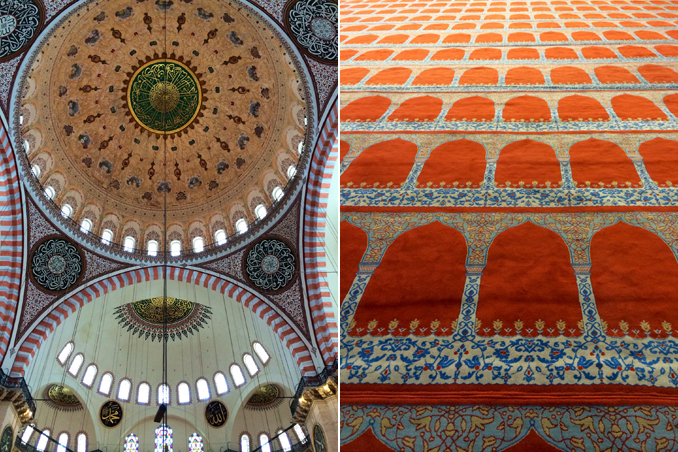 |
Interior of the Suleymaniye Mosque |
One of Sinan’s most famous works, if not the most famous, was built on the orders of Süleyman the Magnificent in 1558 as well. The Süleymaniye Camii, also on the third hill, is counted among the grander mosques and the silhouette of its majestic dome and minarets stands out against the city’s skyline. Said to be inspired by the Byzantine structure of the Hagia Sophia, the dome of the mosque was the highest in the Ottoman Empire at the time it was built. Iznik tiles with intricate flowers adorn the insides of the mosque while the red carpet laid out on the floor contrasts beautifully with the white and ivory walls. Süleyman the Magnificent and his wife Haseki Hürrem are among those whose tombs are found within the mausoleums in the garden behind the mosque. Sinan isn’t too far from his greatest patrons, with his tomb just outside the mosque.
The largest mosque of the city and easily one of its best-known sights, the Süleymaniye Camii is a monumental example of the classical Ottoman architecture and also inspired the structure of Istanbul’s favourite tourist attraction, Sultan Ahmet Camii, famously known as the Blue Mosque. Designed by Sedefkâr Mehmet Aga, who was Sinan’s apprentice, the Blue Mosque gets its name from the 20,000 richly decorated blue tiles from Iznik which cover its interior. Sultan Ahmed I decided to build the great imperial mosque after the wars with Persia proved unfavourable for the Ottoman Empire. It was built on the site of the Great Palace of Byzantium, facing the Hagia Sophia. The opening ceremony was held in 1617 and to this date, the mosque is a popular choice for Muslims to offer their prayers. The mosque’s külliye housed a number of social and cultural buildings as well as the sultan’s mausoleum.
From the gate opening to the inner courtyard, the domes can be seen rising above one another in beautiful symmetry. A heavy iron chain hangs from the entrance on the western side, the purpose of which was to make the sultan lower his head in a gesture to show humility to God. When it was revealed that the Sultan Ahmet Camii would have six minarets, making it the first of its kind in Istanbul, the sultan was criticised for rivalling the Sacred Mosque of the Ka’aba in Mecca. The matter was, however, resolved when he ordered a seventh minaret to be built at the Masjid in Mecca. The impressive domes and minarets of the mosque are covered with lead and at the top are crescents made of gold-plated copper.
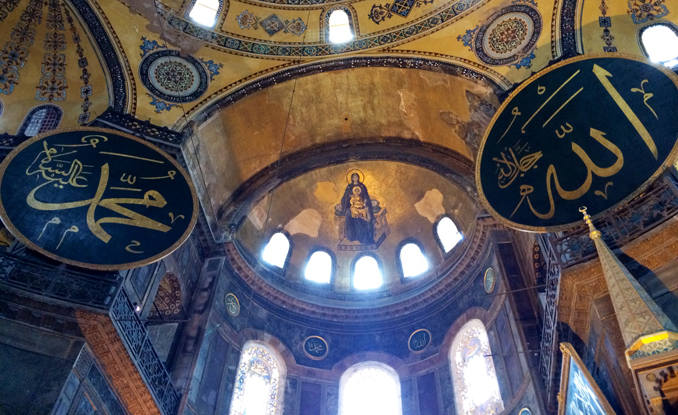 |
Interior of the Ayasofya Mosque |
It wouldn’t be wrong to say that the splendour of the Blue Mosque is enhanced by another vision of grandeur which stands across from it – the Hagia Sophia (Holy Wisdom). Some say that Sultan Ahmed I wanted to construct the Blue Mosque to rival the Hagia Sophia in beauty, but when it came to history, the latter was centuries ahead of any other structure in the city. Originally built as a church, its construction began during the reign of Constantine the Great but wasn’t completed till AD 360 under the rule of Constantine II. It only stood until 404 AD when a rioting crowd burned the church down. A second church was built in 415 but this was also burned to the ground in a rebellion in 532 AD. Only 39 days after the destruction of the second church, the Emperor Justinian I ordered construction to start on a third church. The first two basilicas had used the traditional design of western cathedrals but Justinian wanted something unique and so he hired two Greeks to design the building that stands today. Isidorus of Miletus, a physicist, and Anthemius of Tralles, a mathematician, came up with a structure featuring domes and half domes that is said to have changed the history of architecture. The interior of the building was adorned with four acres of gold mosaics on the ceiling and multicoloured marble was used on the walls, floors and columns.
Built by the most skilled artisans and labourers, this sanctuary was the foremost wonder of the Byzantine era and the largest cathedral in the world for nearly a thousand years, even surviving the earthquake of 1344. Following the conquest of Constantinople in 1453, Mehmed the Conqueror found the church in ruins and at once ordered it to be transformed into a mosque. Its holy relics were removed, inscriptions from the Quran were painted on the interior of its great dome, and four minarets were built around its exterior. In the mid-nineteenth century, six large discs bearing the name of Allah, the Muhammad (pbuh), and the first caliphs and imams were added to its interior, completing the Hagia Sophia’s transformation into the Ayasofya Mosque.
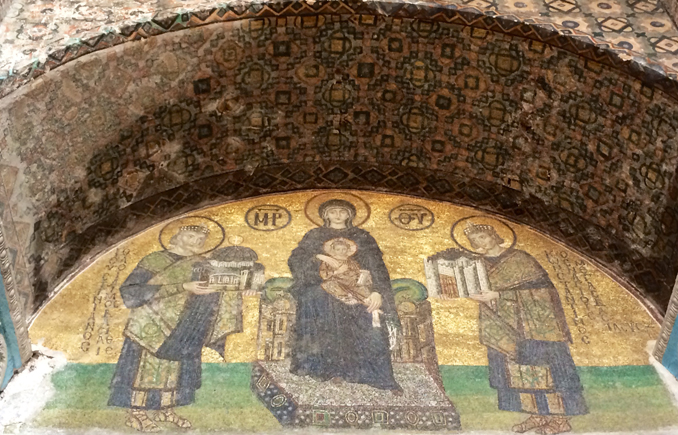 |
It remained a mosque until the founder of the Republic of Turkey, Mustafa Kemal Atatürk, turned it into a secular museum in 1934, also restoring many of the medieval mosaics which had been covered for hundreds of years. Today, by law, the structure cannot be used as a place of worship – it only serves as a surviving testament to Istanbul’s two historic cultures. The mosaics featuring the Virgin Mother, Jesus and saints, and the calligraphy from the Holy Quran, are a rare blend of the iconography of the two faiths, which, after centuries of battle, exist in peace in the gold-speckled museum.
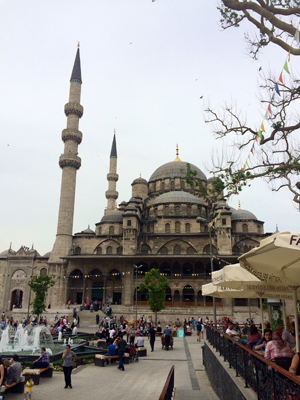 |
New Mosque |
The Blue Mosque and Ayasofya rest on top of the first hill of Istanbul in Sultanahmet. When you come down from the old city to the busy waterfront neighbourhood of Eminönü, there is only one mosque that commands attention – Yeni Cami (New Mosque). Only in Istanbul would a 400-year-old mosque be called new but just to clarify, the name does not denote the time of its construction, which began in 1597. It was commissioned by Sultan Mehmet III’s mother, Valide Sultan Safiye, but following the death of the Sultan and faced with several other setbacks, it was left idle for many years until finally being completed in 1663. The architect who made the initial project was Davut Aga, another apprentice of Mimar Sinan, but the work was completed by Mustafa Aga. The interior is decorated with gold leafs, coloured Iznik tiles and carved marble.
The large Ottoman imperial mosque has perhaps one of the liveliest locations as it overlooks the harbour next to the Galata Bridge on the Golden Horn and at its back is the famous Spice Bazaar, which was originally part of the mosque’s külliye.
The mosques of Istanbul not only add to the city’s mesmerising landscape but also encapsulate its spiritual soul. Be it any part of the city, you’re bound to hear at least one of the five calls to prayer. The muezzin’s voice seems to bounce off the timeless buildings into the ears of the devotees who rush to the mosques to be a part of the congregation. Explore the mosques during the daytime and take in their beauty when sunset falls over Istanbul, but to see them in all their glory, wait for night time when the mosques are illuminated with big spot lights and birds circle overhead, almost as if engaged in a worship of their own.
All images provided by author
Click to view picture gallery
You may also like: